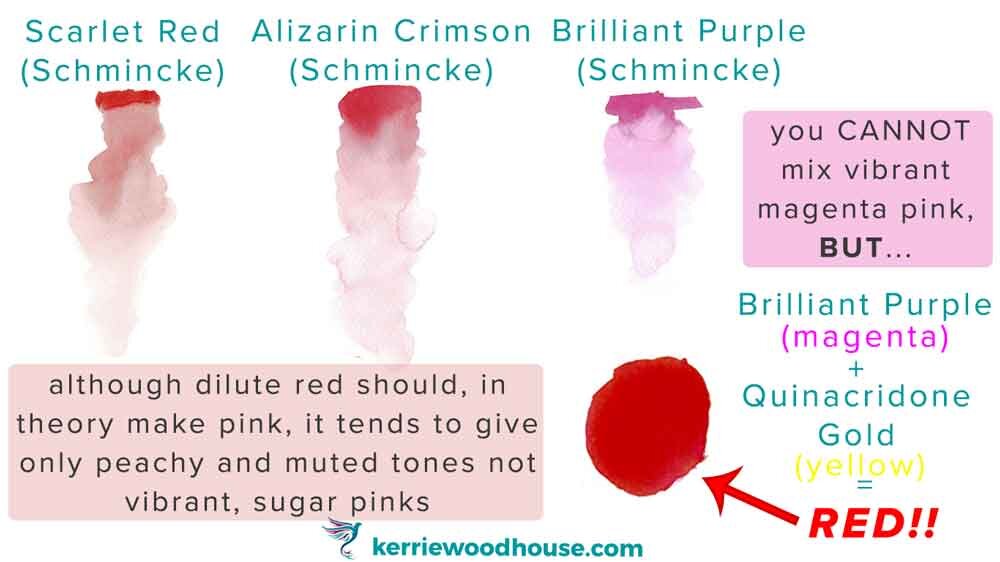Colour mixing for Watercolour Florals - one colour you CAN"T mix 🌈🤔
If you love painting flowers as much as I do you probably also love all the colours 🌈 you get to use when painting florals.
Luckily that doesn't mean you have to buy tonnes of colours (unless you want to), because of course we can always mix a whole range of hues.
Except one.
Actually I know what you are thinking… surely there are 3 colours you can’t mix - the primaries, red, blue and yellow.
Yes, that is the definition of primary colours (that you can’t mix them) but let’s circle back to that in a minute.
The colour I mean is not red, blue or yellow - its actually pink! And if you have ever found yourself frustrated at not being able to mix a nice sugar pink or fuschia tone before I am happy to report that it's not you - its the pigments and the information that we have been working with.
I made a video to explain what I mean because its nice to be able to actually show you the colours I am talking about.
But of course, I’ll keep explaining below the video, in case you prefer to read!
We probably learned as kids that we can mix pink by adding red to white. Now, as watercolour painters we typically don’t use white paint but that won't stop us!
The reason we don't use white paint is that we have white paper and transparent watercolour paint so if we just dilute the paint with a bit more water, the colour becomes more sheer and we see more of the white paper underneath.
That is just like mixing white in with our colour.
So does this work with red paint?
Sort of.
Perhaps you’ve tried this before and know what I mean.
Usually you get a nice coral, peachy pink, especially if you use a warm red like Cadmium Red or the one I happen to have which is called Scarlet Red.
It might be good enough for a soft rose but if you are after a vibrant sugar pink, or a bright baby pink, you are going to be disappointed.
What if we start with a cooler red, something like an Alizarin Crimson? Well it is a less peachy pink but still a little muted.
If you want a vibrant magenta pink like my Schminke Brilliant Purple or Daniel Smith’s Opera Pink you really have to buy a tube of that colour, because it just can’t be mixed.
Curious… and a little frustrating really. So let me tell you why this is happening.
Remember we said that primary colours can’t be created by mixing other colours? Well if you take that vibrant pink and mix it with a yellow - guess what you get?
Yes, red! 😮
As bizarre as it was to me to watch red appear from my colour mixing endeavours, it does make sense when you remember the printer.
If you have ever changed the ink in a colour printer you will know that it is not red, blue and yellow ink. It is actually Cyan (blue) Magenta (pink) and Yellow.
That is what CMYK means.
The K stands for black, if you are wondering, the only other colour the printer needs to create shades of all the colours. (Like us watercolour painters, the printer also utilises the white of the paper.)
So red is not a true primary under the definition we were using.
When we use a red, we now know that we are actually incorporating both a magenta and a yellow into our colour mix.
No wonder our pink was peach.
There is one other important implication of this little nugget of information for us floral painters.
Have you ever tried to mix a purple and found that you only ever get a very muted, grayish purple?
The reason for that is that there is a little bit of yellow hiding in the red mix. And since yellow is the complementary colour to purple it has the effect of desaturating (greying) the purple making it less vibrant.
But if you use magenta and blue you will find that you get a much more vibrant purple.
Mystery of the muted purples...solved.
So to sum up:
If you are a painter who loves florals and will be wanting to paint bright pinks and purples, you will need to invest in a magenta pink paint to get the vibrancy you might be seeking.
Also, if you are a painter who loves florals, you might like to join me painting this delightful collection of flowers in vases. I will guide you step by step from reference inspiration to finished floral painting.
Click here to see if you can get 4 floral tutorials for less than the price of three!
Are you on your own painting journey?
One of these might be useful…











